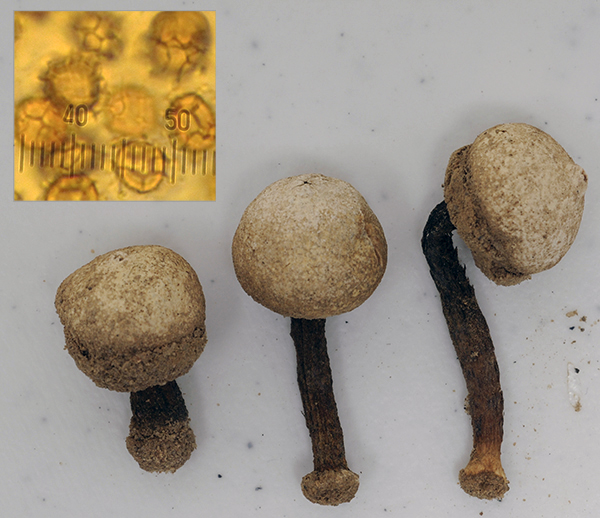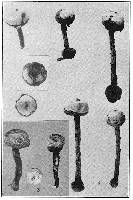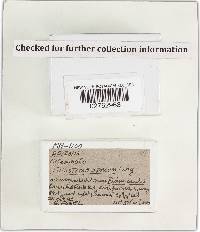
|
|
|
|
Family: Agaricaceae
|
Wright J.E. 1987. Bibliotheca Mycologia 113: 165. Tulostoma opacum Long. (Fig. 108; Pls. II: 1;L:2) - Mycologia 36: 327-329, fig. 3. 1944. Etym.: The name probably refers to the obscure ornamentation of the spores, since it has no other features to which this adjective could be applied. Spore-sac subglobose to somewhat depressed, up to 16 mm diam. Exoperidium thinly membranous, forming a thin cinereous whitish layer inwardly, continuous, on the outside covered by a clayish, dark, chocolate brown or clay-brown, finally caducous layer which persists at the base. Endoperidium finally smooth, almost white, chamois-like, quite tough. Mouth fibrose, of the type of T. fimbriatum, slightly sulcate, somewhat mammose, relatively large for the size of-the spore-sac. Gleba cinnamon ochraceous. Socket conspicuous, hardly at all separated from the stem, membrane unevenly dentate. Stem woody, cortex concolorous with the exoperidium, whitish when decorticated, up to 40 x 5 mm, subequal, ending basally in a small mycelial bulb, decorticating substriately. Endoperidium formed by threads with numerous swollen septa, mostly of slender hyphae, 1.3-3.5 µm diam, branched. Spores globose, some apiculate, brown, strongly reticulate, forming a net that under L.M. appears to have spiny nodes or digitiform elements measuring 1.5-3.5 µm long, sheathed in a hyaline halo; 5.7-7.2 x 5.2-6.1 µm without the ornamentation and 7.9-11 x 7.2-9.4 µm with it; sometimes the reticulum appears incrusted with a crystalline substance. Under SEM the ornamentation appears distinctly alveolate, with unequal meshes and thick-walls, the sporal body minutely verrucose, the "halo" apparently being produced by an optic effect of the alveolar walls. Capillitium scantily branched, hyaline, moderately septate, formed by thick-walled threads, 2.5-7.1 µm diam, with walls up to 1.5 µm thick, slightly swollen at the septa (up to 8.6 um); lumen scant or solid. Habitat: sandy soil in semiarid regions with "chaparral" vegetation. Distribution: North America: United States and Mexico. Holotype: United States: New Mexico, Dona Ana Co., Jornada Exper. Range, 28 mi W of Las Cruces, leg. W. H. Long 8286, 12.XI.1938 (BPI!). Illustration: Long (op.cit.) |









